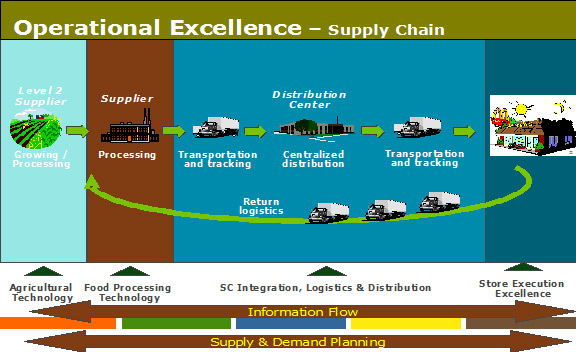McDonald’s is a well-known global fast-food chain that has become incredibly popular due to its affordable and, at the same time, high-quality hamburgers. To be more particular, this company was initially developed from a tiny restaurant with a limited menu ran by the McDonald brothers. As a matter of fact, the businessman Ray Kroc was surprised by the business’ service and the food quality and, therefore, desired to advance it into a restaurant franchise. By and whole, McDonald’s has created an efficient supply chain to enable shipping operations on the domestic market, the USA, and across the globe.
To begin with, as the organization is strongly connected to fast food, fresh produce shipped on a daily basis is an incredibly crucial aspect for running McDonald’s. Today, McDonald’s functions in more than 100 countries worldwide and is presented in 39000 restaurants (McDonald’s, 2021). However, more than 36500 branches are franchised in the USA, and the remaining amount is across other continents. Still, McDonald’s plays a pivotal role in advancing the retail supply chain to advance the company’s operations. For instance, McDonald’s is a multi-national company, conscious of its suppliers and their distribution methods (McDonald’s, 2021).
In other words, McDonald’s has reached flexibility in its supply chain by forcing strict rules regarding the values and environment that suppliers must support in order to work with the organization (McDonald’s, 2021). In addition, McDonald’s cooperates only with those businesses that guarantee the health of animals by rejecting animal food with antibiotics. The company is seriously opposed to animal cruelty and thoroughly analyzes the suppliers’ operating systems before purchasing the ingredients from them. Overall, McDonald’s is planning to decrease the negative influences on the environment by reducing gas emissions along with air and water pollutions.
Another critical point is that McDonald’s is fully responsible for the conditions in which fresh produce is being distributed to its branches in the USA and across the globe. All the vehicles that the company uses for transportation are equipped with temperature-control mechanisms that minimize the risks of the products getting spoiled in the process (Khandenwal, 2020). Besides, the franchise is focused on transporting the products in ecological containers that do not harm nature in any way, considering that the company is highly conscious about protecting wildlife.
The supply chain of McDonald’s includes numerous operations and involved employees, who allow it to function correctly by fulfilling their daily responsibilities of managing supplies. The organization’s provision chain is a complex system based on direct and indirect suppliers motivated by the same passion for high-quality products as Ray Kroc (McDonald’s, 2021). To be more exact, the partnership with direct suppliers mainly focuses on purchasing coordination and further distribution to domestic and international branches (Khandenwal, 2020).
On the contrary, the indirect suppliers are connected to farmers who provide McDonald’s with wheat, vegetables, and ingredients necessary for cooking fast food from restaurants’ menus (Khandenwal, 2020). The distribution centers are responsible for managing the processes regarding the delivery of supplies to the restaurants (Khandenwal, 2020). Overall, the products are received in perfect condition, which stands for the first and foremost policy of McDonald’s franchise, high quality.

Nevertheless, like any company, the operational structure of McDonald’s is also threatened by the occurrence of possible issues. For instance, the competition in the fast-food market is growing day by day as the franchisees similar to this company are developing their marketing strategy aggressively, which consequently negatively impacts McDonald’s restaurants’ chain (McCorkle, 2017). Thus, McDonald’s needs to focus on the advancement of marketing strategy to be a strong rival in the industry (McCorkle, 2017).
Furthermore, with the rise of technology, it is vital to advance McDonald’s brand online on different social media platforms to attract more customers. The amount of waste on the internet often distracts people, so the company needs to seek gripping and unusual ways of differencing from other rivaling fast-food chains. Another critical point is that McDonald’s positions itself on the market as a responsible company aware of environmental issues and contributes to tackling them (Khandenwal, 2020). As a result, the organization needs to focus on the eco-friendly aspect of operational structure, which requires considerable investment. Still, McDonald’s can advance its environmental policy steadily without wasting an enormous amount of money on the new technologies by not employing them all at once.
To sum up, the supply network of McDonald’s is highly advanced since the company needs to distribute and ship fresh produce to the domestic and international branches on a daily basis. Furthermore, the chain’s complex structure is also dependant on following the company’s strict environmental policies, which result in specific means of transportation, careful partnerships with suppliers, and more expensive packaging. Nevertheless, the effectiveness of McDonald’s provision chain cannot be seriously stabilized by any external threats as the system is incredibly advanced and functions perfectly with the help of suppliers and the organization’s employees. Still, any possibilities of problems’ occurrences can be easily solved in the short term without any damage or harm to the company’s operational structure.
References
Khandelwal, R. C. (2020). An overview of the supply chain of restaurant giant McDonald’s. Market Realist. Web.
McCorkle, K. C. (2017) McDonald’s all day breakfast launch: The strategic value of McDonald’s supply chain. Purdue University.
McDonald’s. (2021). Our history. Web.
